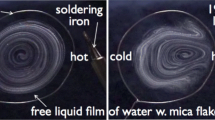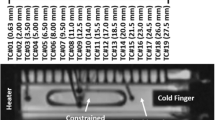Abstract
The surface tension driven flow in the liquid vicinity of gas bubbles on a heated solid wall has been investigated both, in a reduced gravity environment aboard a sounding rocket, and in an earth-bound experiment. Both experiments deal with temperature gradients within the liquid surrounding of a bubble which cause variations of the surface tension. These, in turn, lead to a liquid flow around the bubble periphery termed thermocapillary or thermal Marangoni-convection. On Earth, this phenomenon is widely masked by buoyancy. We therefore carried out an experiment under reduced gravitational acceleration. In order to simultaneously observe and record the flow field and the temperature field liquid crystal tracers have been applied. These particles offer the feature of selectively reflecting certain wavelengths of incident white light depending on the crystals temperature. Although the bubble injection system did not perform nominally during the flight experiment, some interesting flow characteristics could be observed. Comparison of results obtained in microgravity to data measured on Earth reveal that due to the interaction of thermocapillarity and buoyancy a very compact vortex flow results on ground, while in microgravity the influence on the surface tension driven flow penetrates much deeper into the bulk. This result is of special interest regarding the production of materials in space.
Similar content being viewed by others
References
Minster O (1995) Facilities for microgravity investigations in physical sciences supported by ESA. Special publication of the european space agency ESA SP-1116
Nozaki T; Mochiziki N; Kaji N; Mori YH(1995) Application of liquid-crystal thermometry to drop temperature measurements. Exp Fluids 18: 137–144
Raake D; Siekmann J; Chun ChH (1989) Temperature and velocity fields due to surface tension driven flow. Exp Fluids 7: 164–172
Wozniak K; Wozniak G; Rösgen T (1990) Particle-image-velocimetry applied to thermocapillary convection. Exp Fluids 10: 12–16
Wozniak G, Wozniak K (1994) Buoyancy and thermocapillary flow analysis by the combined use of liquid crystals and PIV. Exp Fluids 17: 141–146
Author information
Authors and Affiliations
Additional information
Dedicated to Professor Dr. Julius Siekmann on the occasion of his 70th birthday
The work described herein was supported by the German space agency DARA (Deutsche Agentur für Raumfahrtangelegenheiten GmbH) through DARA Grant 50 WM 9434. The authors thank the European Space Agency (ESA) for the opportunity to conduct the TEXUS 33 sounding rocket experiment. The flight hardware has been partly built by Daimler-Benz-Aerospace which is gratefully acknowledged. Also, the authors are indebted to Mr. H.-H. Wolf for his careful evaluation of the particle images
Rights and permissions
About this article
Cite this article
Wozniak, G., Wozniak, K. & Bergelt, H. On the influence of buoyancy on the surface tension driven flow around a bubble on a heated wall. Experiments in Fluids 21, 181–186 (1996). https://doi.org/10.1007/BF00191690
Received:
Accepted:
Issue Date:
DOI: https://doi.org/10.1007/BF00191690




